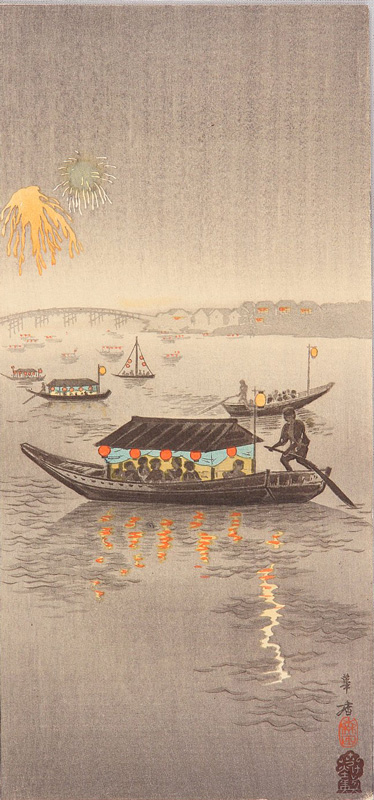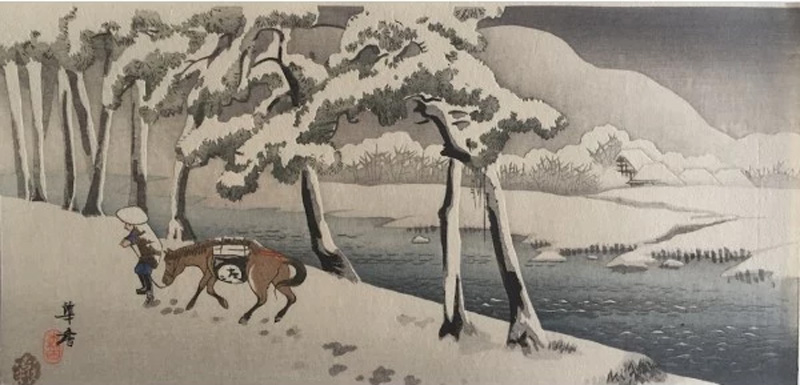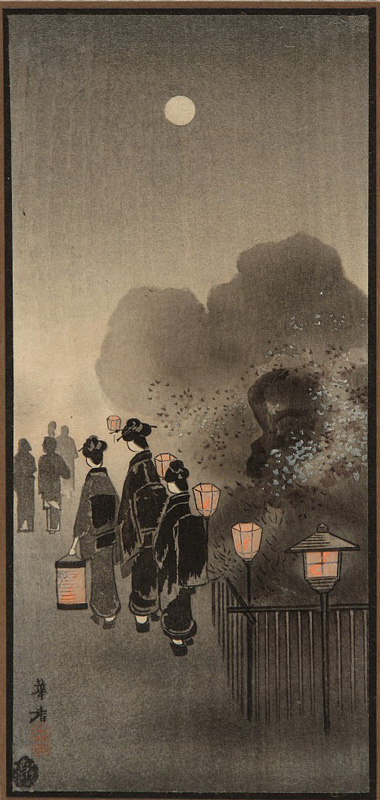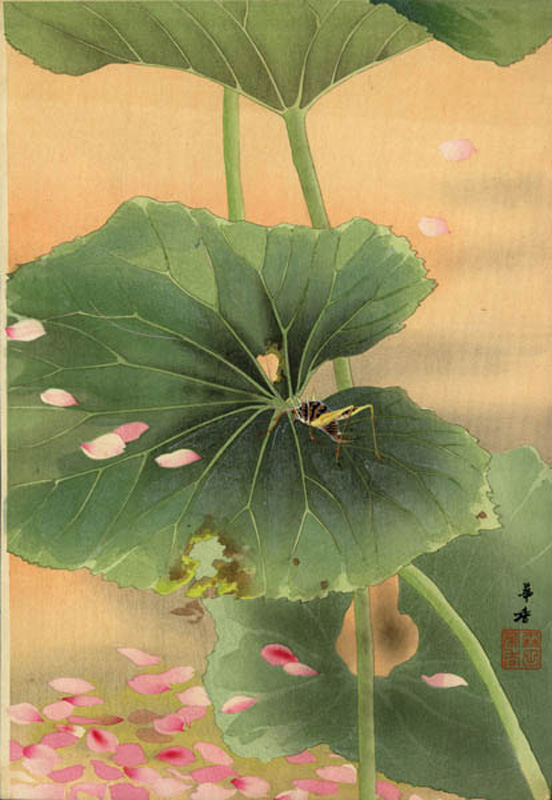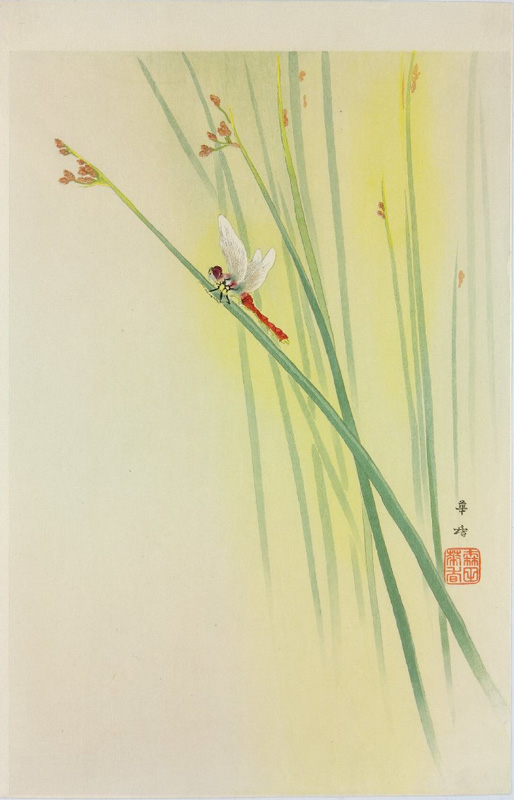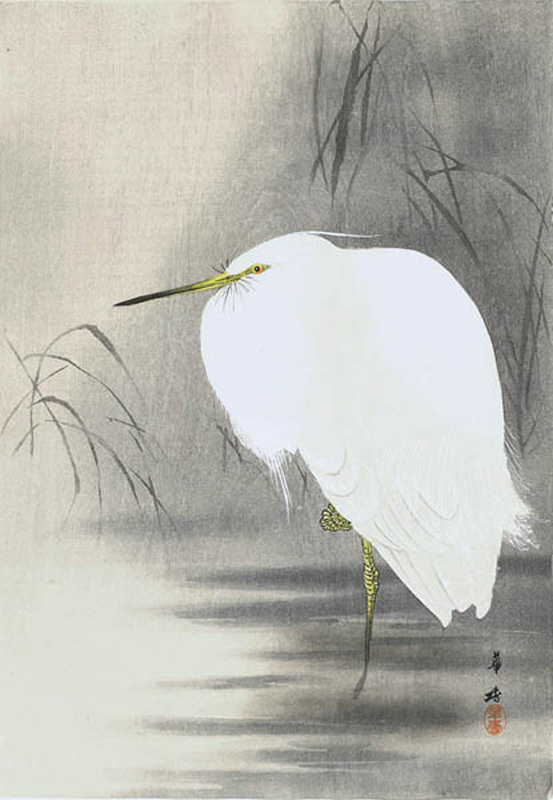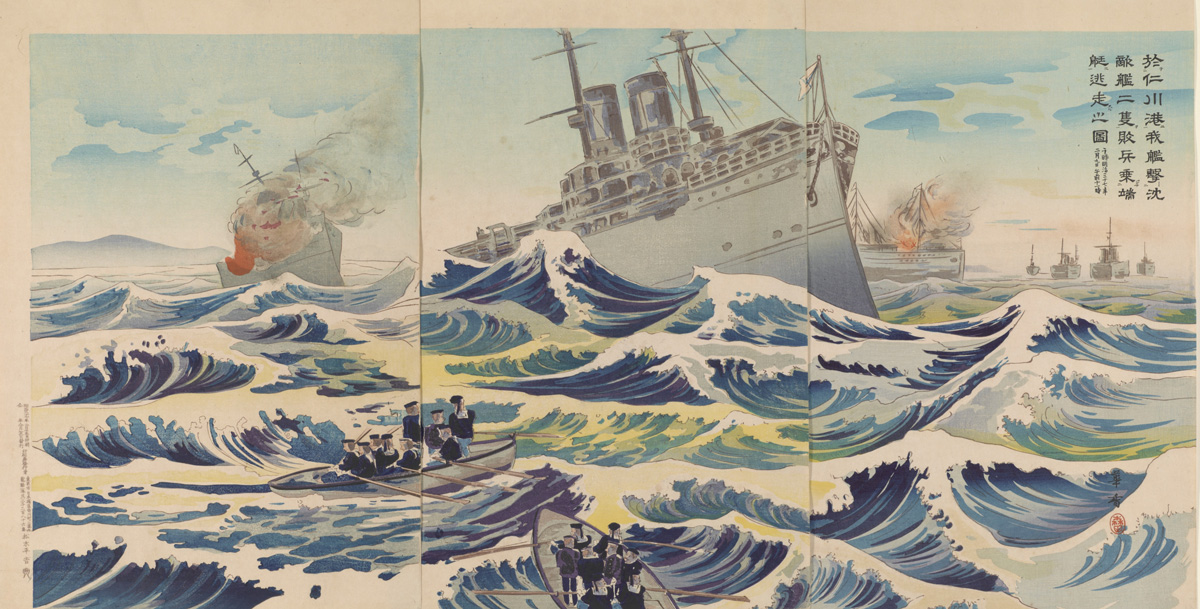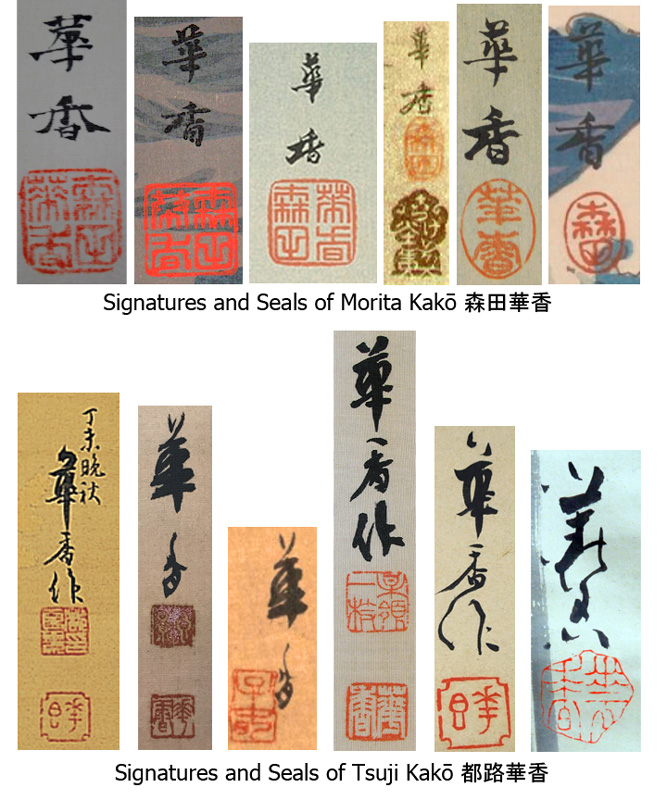Biography
Morita Kakō 森田華香 (active c. 1904/1930)
Nothing is known about the personal life of this nihonga artist who designed both war prints (senso-e) during the Russo-Japanese War (1904-1905) and bird and flower prints (kacho-e) from about 1910 through 1930. As a nihonga artist he created a number of ink on silk works, one of which is shown below.
Morita designed prints for at least two different publishers during his career - Akiyama Buemon (Kokkeidō), who published a number of the artist's landscape prints, and Matsuki Heikichi (Daikokuya), who published the artist's twenty-or-so kacho-e and his four known Russo-Japanese War prints.
A sampling of prints published by Akiyama Buemon (Kokkeidō), c. 1910/1930
(print titles are descriptive)
A sampling of prints attributed to Matsuki Heikichi (Daikokuya), c. 1910/1930
(print titles are descriptive)
Prints published by Matsuki Heikichi (Daikokuya), 1904
| Destruction of Two Russian Battleships, 1904 | Sinking of a Russian Warship during the Great Naval Battle at Port Arthur, 1904 |
A painting of Morita's titled Late Autumn was awarded honors at the 4th exhibition of Jitsu-getsu Association 日月会 (The Sun and Moon Association) and reproduced in the November 20, 1904 issue of the art magazine Bijutsu Gaho.1 He also contributed one or more illustrations to the popular magazine Fuzoku Gaho, the first graphic magazine produced in Japan. Records of The American Art Association, which offered four of Morita's ink on silk paintings in their 1901 New York auction, list his works under "Paintings from the Pupils of Professor Okakuya's [sic - Okakura Tenshin (1863-1913)] Art Institute, Tōkyō" providing the only information I've been able to discover on Morita's training as an artist.2
Confused with Tsuji Kakō
Morita is often confused with another, and better known, nihonga artist Tsuji Kakō 都路華香 (1870/1871-1931), who was not a print designer. Adding to this confusion is that Morita's birth and death dates, when given, are often identical to Tsuji's. This, of course, may just be a true coincidence. While both artists used "Kakō", spelled with the same kanji characters 華香, comparison of their signatures and seals, shown below, strongly suggests that they are two different artists. In addition, the name Morita has never been associated with Tsuji Kakō, whose work is found in many museums and whose biographical details are well known.
click on image to enlarge
Is Morita Kakō the Scientific Illustrator Morita Kako (aka K.M.)?
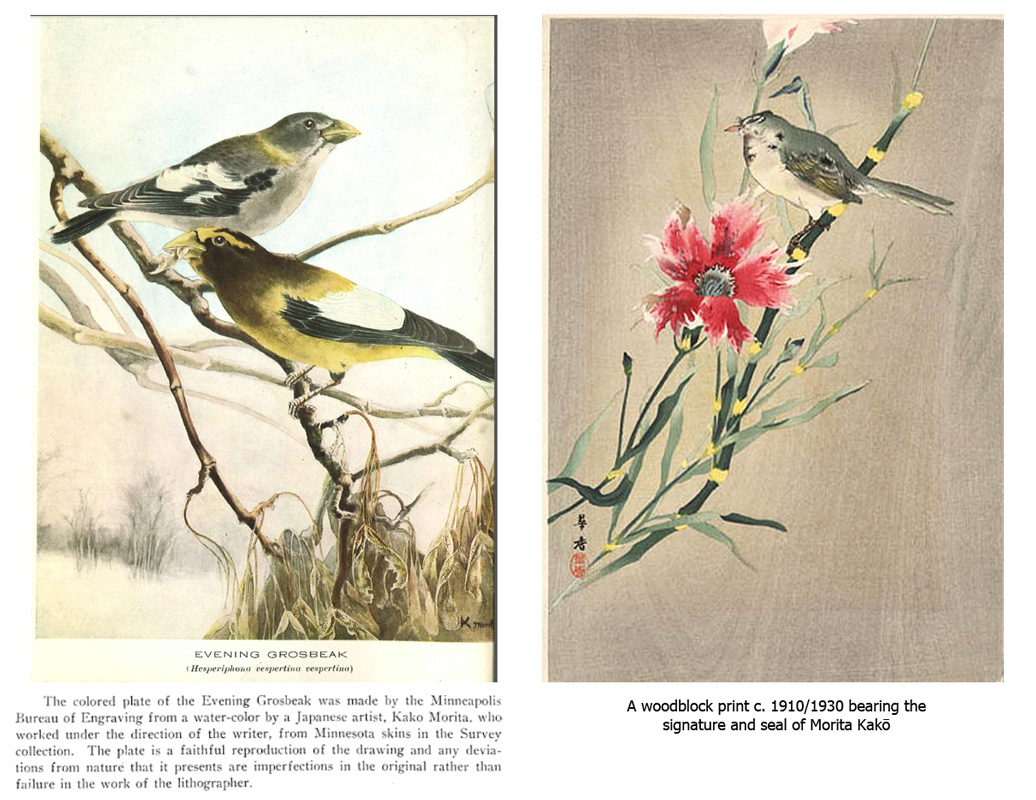
click on image to enlarge
The University of Stuttgart's Database of Scientific Illustrators 1450-1950 contains the following listing:3
Morita, Kako
Dates of birth and death: 1870 - 1931
Also known as: K. M. ;
Worked for: Nathaniel Lord Britton (1859-1934) & Joseph Nelson Rose (1862-1928): Cactaceae (1919-23) ; David Star Jordan (1851-1931): Guide Study of Fishes (1905) & Fishes Samoa (1906) ; David Starr Jordan (1851-1931)
Could this botanical illustrator be the same Morita Kakō who created beautiful kacho-e as shown above?
The website of the University of Minnesota Natural History Museum has a number of Morita's botanical illustrations and provides the following information on the artist:4
In 1904, Kako Morita, a graduate of the University of Tokyo, was hired by Henry Nachtrieb, professor of Animal Biology and State Zoologist, and Thomas Sadler Roberts, then a contributor to ornithological studies for the Survey, to paint fish and birds to be used to illustrate reports on zoology and ornithology. Only a few traces of Morita’s connection to the University have yet been found: a line of credit as the artist of the illustration of an Evening Grosbeak included in T.S. Roberts’s Occasional Paper #1, [shown above] a brief article in the October 3, 1904 edition of the Minnesota Alumni Weekly, and a mention by Walter Breckenridge in an article in a publication of the Minnesota Ornithological Union. As evidenced by the presence of these images of beans and berries, Morita produced illustrations of botanical specimens for the Department of Botany as well.

click on image to enlarge
The scientific illustrator Kakō also had connections with Stanford University's David Starr Jordan (1851-1931), who mentions him in his memoirs as providing "paintings of fifty of the most brilliant species" later published in 1906 in The Fishes of Samoa.5 A "Morita, Kako, Assistant Artist, 1902-03" is also listed under faculty in the Stanford University 1921 Alumni Directory and Ten-Year Book III 1891-1920.6 Morita also worked at the Carnegie Institution of Washington and his name appears multiple times in their 1910 yearbook.7 His botanical illustrations of cacti can be found in the collection of the Smithsonian National Museum of Natural History, which carries the following biographical notes on the artist.8
Kako Morita (fl. 1902-17) prepared about a dozen illustrations for Britton and Rose's The Cactaceae (1919-1923). These were done between 1909 and 1911. We know of no other botanical illustrations that he prepared. He was, however, an accomplished illustrator and prepared many illustrations of fish for David Star Jordan (1851-1931), an ichthyologist and first president of Stanford University. Examples of Morita's fish illustrations may be seen in two works by Jordan; a text book entitled Guide to the Study of Fishes (1905) and a scientific monograph entitled The Fishes of Samoa (1906). In addition, the semi-popular book Fish Stories (1909), written by C. F. Holder and D. S. Jordan, reproduces illustrations by Morita.
Examples of Morita's artwork are in the permanent collections of the Department of Botany and the Division of Fishes, both Smithsonian Institution.
It is worth noting the year 1904, the date of Morita's hiring by Henry Nachtrieb and Thomas Sadler Roberts, as mentioned above, would have coincided with the year his teacher Okura Tenshin moved to Boston to take up his position at the Museum of Fine Arts, Boston.
Rhiannon Piaget, in her notes on the artist Morita Kakō in Conflicts of Interest: Art and War in Modern Japan, writes:9
The artist Morita Kakō left only a handful of battle-print designs.. The artist's identity remains obscure, but the brushstroke-like rendering of this design suggests the identification of Kakō with a Tokyo painter of the same name and approximate age, who emigrated to the United States around the time of the war and established a successful career as a scientific illustrator there. However, there is yet no concrete evidence to link the scientific illustrator with the artist of this print, nor is it simple to explain why or how an expatriate artist's design might have been printed in Tokyo within days of the outbreak of the war.
Samples of Artist's Signature and Seals
 華香 / 森田 Kakō / Morita | 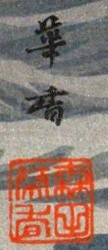 華香 / 森田華香 Kakō / Morita Kakō |  華香 Kakō | 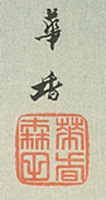 華香 / 華香森田 Kakō / Kakō Morita |
1 Website of Independent Administrative Institution National Institutes for Cultural Heritage https://www.tobunken.go.jp/materials/gahou/210521.html
2 Japanese Pictorial Art..., American Art Association, 1901, p. 17 https://archive.org/stream/b15164895/b15164895_djvu.txt
3 University of Stuttgart Database of Scientific Illustrators https://dsi.hi.uni-stuttgart.de/index.php?tablename=dsi&function=search&where_clause=&order=lastname&order_type=ASC&page=768
4 University of Minnesota https://editions.lib.umn.edu/naturalhistorymn/2013/08/30/friday-flora-nature-and-art/
5 The Days of a Man Being Memories of a Naturalist, Teacher, and Minor Prophet of Democracy · Volume Two 1900-1921, World Book Company, 1922, p. 117.
7 Carnegie Institution of Washington, Year Book, No. 9, 1920, published by the Institution, 1921, p. 120, 122, 127, 255.
8 Smithsonian National Museum of Natural History https://collections.nmnh.si.edu/search/botany/?ti=6]
9 Conflicts of Interest: Art and War in Modern Japan, Philip K. Hu, et. al., Saint Louis Museum of Art, 2016, p. 214.
last revision:
last revision:
4/22/2020 created



